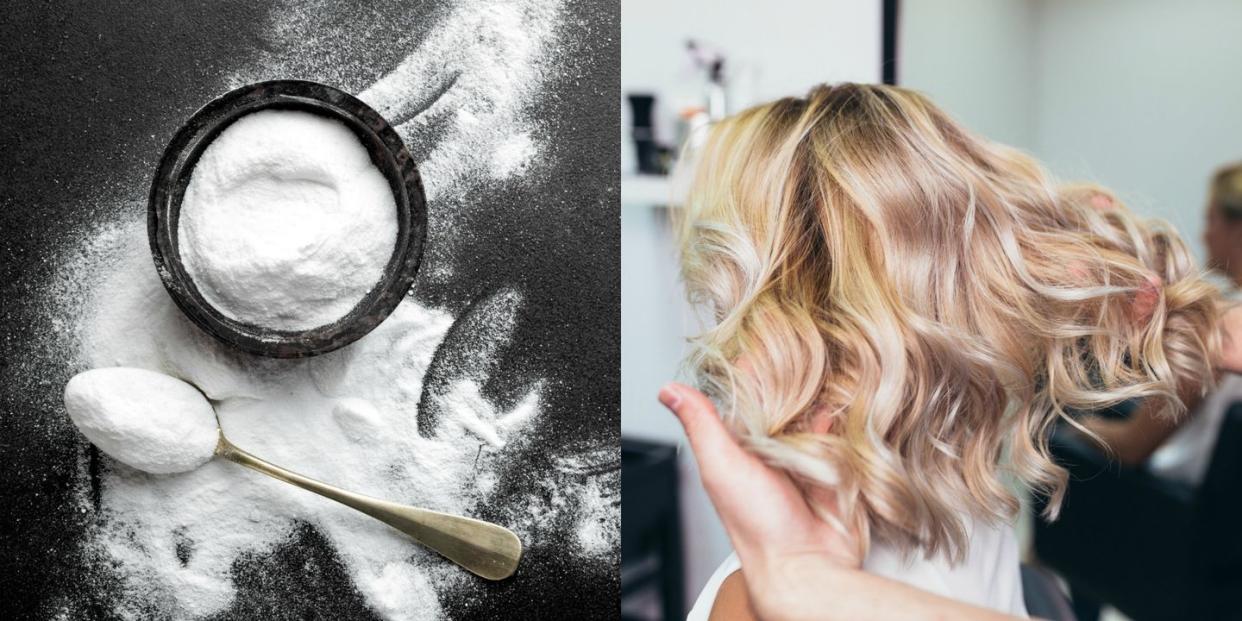People Are Using Baking Soda As a "Natural" Shampoo, But Does It Work?

Baking soda—you know it and love it for making the dough for your homemade bread or cookies rise, and it may even be the secret ingredient in your deodorant or toothpaste. But would you be willing to toss out all the yummy-smelling, expensive bottles of shampoo lining your bathtub and clean your hair with the powdery stuff instead?
Skipping commercial shampoo—or going "no-poo," and using only inexpensive, natural products you'd find in your pantry—is a trend that's been bouncing around the internet for a while. You can find many blogs that recommend washing your hair with baking soda dissolved in water, and then rinsing it with diluted apple-cider vinegar. Fans claim this homemade method removes oil and buildup, leaving your hair clean, soft, and shiny.
But experts who look at hair and scalps every day say that while the harshly abrasive baking soda may very well remove oil and dirt from your hair, it may also leave you with an irritated scalp and badly damaged strands.
“I get asked every day, how often should I shampoo my hair, and is shampoo bad for my hair?” says trichologist (i.e., hair scientist) Penny James, of New York’s Penny James Salon. “And while I do recommend rinsing with apple cider vinegar, I don’t advise using baking soda to cleanse the scalp and hair.”
Dermatologist Mona Gohara, M.D., clinical professor at Yale School of Medicine, is likewise skeptical: “I’m not a big fan,” she says. “I’m not anti-DIY—I love a little mineral oil on the scalp—but baking soda can be really damaging to the scalp.”
A little chemistry lesson
Remember back in high school chemistry class, when you would dip those litmus papers in liquids to see if they were an acid or a base? Well, here’s the thing: Baking soda is another name for sodium bicarbonate, which has a pH level of 9, making it very basic (and not in the way your teen daughter means basic). “The higher the pH level, the harsher the product is for the hair,” says James. “If you wash your hair with diluted baking soda, the hair cuticle will be flared, drying out the hair shaft, which will make your hair very difficult to manage and may cause breakage.”
Not only can the baking soda damage the hair shaft, it can also harm your scalp, says Dr. Gohara. “The skin has a natural pH of 5.5, which is a little acidic, so you want to use products with a neutral pH. Shampooing with baking soda can cause redness, inflammation, and itchiness on the scalp.”
Blogs that recommend the no-poo baking soda method usually claim that any potential damage from the high-pH product will be offset by rinsing your hair with acidic apple-cider vinegar, which has a pH level around 3. James says they are actually on to something with the vinegar rinse: “Acidic solutions help the cuticle layer lay flat, which makes the hair look glossy and helps maintain the hair shaft moisture.” However, she advises clients to just skip the harsh baking soda step, and go straight to the soothing vinegar rinse.
Shampoo gently
James recommends you save the baking soda for your baking needs, and instead use a gentle shampoo every other day, massaging the shampoo into the scalp and letting the lather flow down the shaft of the hair. “Pollution in the air, product buildup, excessive oil on the scalp—or excess dryness on the scalp—can all affect our hair, so it’s important to use a shampoo with a pH level of 5.5, which helps our hair stay healthy,” she says.
While there is no requirement for shampoos to list their pH level on the label, several brands claim to strike the perfect balance of 5.5—equal to the pH of the scalp. Two to try: Tree to Tub Soapberry for Hair ($17.88 for 8.5 oz) and pHat 5.5. Seborrheic Dermatitis Shampoo ($13.91 for 4 oz).
And if you stocked up on baking soda hoping it would solve all your hair problems, well, you can always use it to bake this delicious loaf of pumpkin bread.
Like what you just read? You’ll love our magazine! Go here to subscribe. Don’t miss a thing by downloading Apple News here and following Prevention. Oh, and we’re on Instagram too.
You Might Also Like

